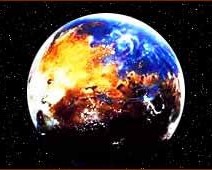 |
| What We Know About the Red Planet | ||||
| History | Water | Ice | Air | Canals |
| Seasons | Mountains | Rocks | SandDunes | Rift Valley |
| Moons | Dust Storms | Stats | Closest | Kid Pix |
| Lunar | Movies | Life Search | Wanted | Exploring Mars |
We know a lot about Mars:
History of Human Study of the Red Planet
RECENT DEVELOPMENTS: MARS EXPLORATION ROVERS MARS CLOSEST TO EARTH IN 59,619 YEARS
No other world has tickled the human fancy more than Mars.
Pathfinder sees distant twin peaks on the rocky Martian surface in 1997
Click to enlarge NASA image
Despite all of the excitement in recent decades over astronuats, space stations and exploding galaxies, it still seems nothing in Outer Space fires the imagination more than the Red Planet.
Why red planet? Ancient Romans surely didn't know much about Mars, except it was a planet and it was red. They saw it as an angry light in the heavens worthy of the name of their mythical god of war.
Today we still call Mars the Red Planet because it is easily distinguished in the night sky by its reddish color which comes from rusty sand and rocks that cover the Martian surface.
It doesn't always look red. When viewed from Earth, the color can be seen to change. When it appears to be red, the viewer is seeing the surface of the planet. When it appears to be gold, there is a major dust storm on the planet.
Ice caps. A century ago, astronomers became intrigued by the planet's regularly-changing polar caps, surface markings and dust storms, changes attributed to Mars' inclined axis. That gave Mars seasons, like Earth. In fact Mars looked so much like Earth, some thought it might be inhabited.
Channels. A century ago, when Italian astronomers peered though their telescopes at the planet's surface, they saw lines on the ground which they called channels. Unfortunately, when their Italian word was translated into English, the lines came out as canals.
Well, everybody knows canals are artificial waterways built by intelligent beings, so, as a result, science fiction authors found a new source of scary tales about little green men. H.G. Wells wrote the now-famous "War of the Worlds" which some say is the greatest Mars story ever told.
A sci-fi darling. Interestingly, science fiction books and short stories inspired many of today's scientists and astronauts to work in the space program which has sent several spacecraft to orbit the Martian world and send landers down to its surface.
Solar System position. Mars and Earth are two of nine planets in our Solar System. Outward bound from the Sun, Mercury is first, Venus is second, Earth is third and Mars is fourth. The four are known as the terrestrial planets. Mars is 1.5 times farther from the Sun than Earth while it is only about half as large as Earth.
Similarities to Earth. Mars is more of an Earth-like world than any other planet in our Solar System. Its period of rotation and inclination of its axis are similar to Earth's. Its density tells us it's made of rocky materials, however with less iron and more lightweight elements and volatiles than Earth. Mars' atmosphere is thin enough to allow observation of the surface.
Viking orbiter sees the Grand Canal of Mars, Valles Marineris, in 1976
Natural satellites. Among the terrestrial planets, only Earth and Mars have satellites. Earth has its Moon and Mars has two very tiny natural bodies in orbit named Phobos and Deimos.
Atmospheric temperature. Mars has a very thin atmosphere, mostly carbon dioxide. The surface temperature varies from -194 to 80 degrees Fahrenheit.
Geologically diverse. U.S. and Russian space probes have revealed Mars to be a complex, geologically-diverse world with immense volcanoes, a great rift valley and ancient river beds.
Revolving sphere. The rotation period of Mars is merely 37 minutes longer than Earth's, a fact known as far back as the late 1600s when astronomers observed the motion of surface features.
The rotation axis is tilted with respect to the orbital plane by almost 24 degrees, so that both Earth and Mars experience significant seasonal differences in the amount of sunlight falling on a hemisphere during the year.
The difference between Winter and Summer is more extreme on Mars, due to the greater eccentricity of the Martian orbit.
Astronomical distances. The distance of Mars from the Sun ranges from 128.4 million miles (206.7 million kilometers) at closest point (perihelion) to 154.7 million miles (249.1 million kilometers) at farthest point (aphelion). That's a difference of 26.3 million miles (42.4 million kilometers).
By comparison, Earth's distance from the Sun changes by only about 1.6 million miles (2.5 million kilometers).
Therefore, the Red Planet receives 40 percent more sunlight during its southern Summer, when nearest the Sun, than during its southern Winter, when the Sun is most distant. That makes for relatively hot southern Summers and mild northern Winters, but cool northern Summers and cold southern Winters.
Learn more: Human Exploration of Mars:
There have been three stages of exploration so farFlybys:
Probes fly by Mars taking pictures Orbiters:
Spacecraft fly into orbit above MarsLanders and Rovers:
- Orbiters
- Mariner 8-9
- Viking 1-2
- Mars Observer
- Mars Climate Orbiter
- Mars Global Surveyor
- Mars Global Surveyor home
- 2001 Mars Odyssey
- 2001 Mars Odyssey home
- Mars Express
- Mars Express home
- Mars Reconnaissance Orbiter 2005
- Mars Reconnaissance Orbiter home
Landers and rovers drop to the surfaceSand dunes: Dust Storms: Air: Carbon Dioxide: Outflow Channels: Valley Networks: Rift Valley: Ice: Ice caps: Frost: Water: Artesian Water: Mars Weather: Mars Photo Galleries: Planet features: Canals: Rocks: Mountains: Dating and aging: Seasons:


